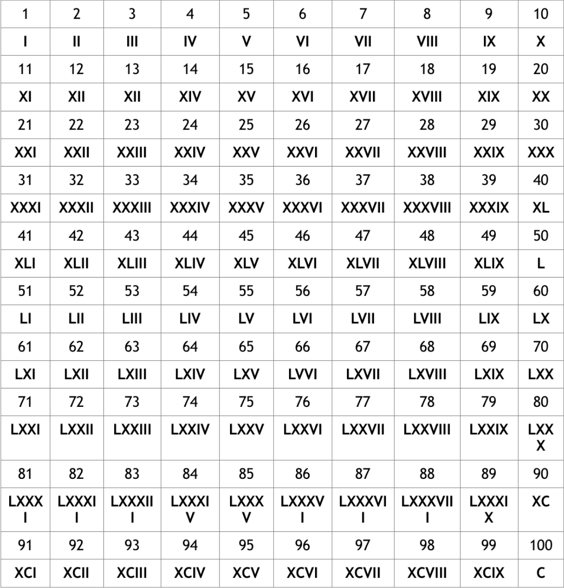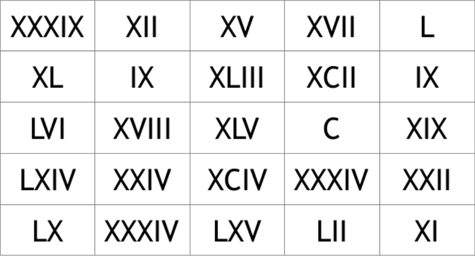Roman Numerals: Fun teaching strategies for Year 4
Although Roman Numerals are not used frequently today, it’s important for children to see numbers represented in different ways.
Children will still see Roman numerals in lots of real-life contexts as they are a rich part of our cultural heritage, they teach basic maths facts, and they can be fun to learn!
Why do children need to learn these cumbersome relics from the past? Well, firstly it’s one of the statutory requirements to ‘read Roman numerals to 100 (I to C)’ in the Year 4 maths programme of study for Number. But, I also find that learning Roman numerals is a great way to help children increase their number sense, better understand how numbers work, and is particularly good for increasing mental maths skills.
Where to begin
It’s worth talking to the children about the history of Roman numerals to help them realise the various counting systems in the ancient world before the creation of Roman numbers and our own numerical system. For example, you could talk to them about the Etruscans, who lived in central Italy before the Romans and had their own numeral system with different symbols.
Give the children some context on how Roman numbers were widely used throughout the Roman Empire in everyday life and, following the fall of the Roman Empire, how they were used throughout Europe up until the 1600’s. Ask them to think about where they may have seen Roman numerals recently and show examples used on clocks, buildings and monuments.
Learning the basics
Initially it’s vitally important for children to learn what Roman numerals look like, how they combine together to make different numbers and how to read/convert them. Understanding what Roman numerals represent can feel like deciphering a code. It can be challenging but can also present some really fun options for learning.
To get started, show children ‘the basics’. While Year 4 are only required to learn 1-100, there’s no reason why you can’t also introduce 500 = D and 1000 = M and share with them all 7 symbols.

Remembering I, V, X, L, C, D and M can be tricky, so ask the children to make up a sentence to help such as:
“I Value Xylophones Like Cats Devour Milk”
“If Vera’s X-ray Looks Clear Don’t Medicate”
“I Viewed Xavia Leaping Carelessly Down Mountains”
Another great way to help children learn these numerals is to play a simple recognition game such as a classic ‘Four In A Row’ game:
What you will need:
- Sticky labels to cover a 1-6 die in the Roman numerals V, X, L, C, D and M
- Some coloured counters
- A playing board

What to do:
- Find a partner, this is a game for two players.
- Take turns to roll the die. When you see your number, cover it up using one of your counters.
- The first player to get four numbers in a row (horizontally, vertically or diagonally) is the winner.
Become Qualified to Make a Difference
Empower yourself to create a lasting impact in pupils’ lives. Gain maths mastery certificates that will represent all you’ve accomplished and learned in your teaching journey.
From Fellow, to Expert, to Master — you can take the pathway to certified success!

How to combine numerals
It is important to help your pupils understand that numerals can be combined to make lots of different numbers. I tend to show them a 1-100 Roman numeral square then I explore various number combinations and explain how the numerals ‘work’.

The key rules are that when a symbol appears after a larger symbol, it is added (eg: VI = V + I = 5 + 1 = 6), and when a symbol appears before a larger symbol it is subtracted (eg: IX = X – I = 10 – 1 = 9). You can make up a rhyme or saying that can help with the learning:
When “left” is small and “right” is bigger,
Subtract the “left” from “right-hand” figure.
Arguably, the first 12 Roman numerals are the most important to focus on as these are the numerals need for telling the time. Students should then also become aware that they shouldn’t use the same symbol more than three times in a row (e.g. 4 is written as IV not IIII).
You may decide to use a partially completed 1-100 square for children to complete themselves so they become familiar with the combinations or you play the Roman Numeral Bingo game:

What to do:
- Read out numbers for children to spot on their Bingo cards. You can give each child a 1-100 number square of Roman numerals to help them.
- When children see the number on their card they cross it off.
- The first child to mark off a winning pattern is the winner.
Games that teach, build or strengthen maths skills and concepts while having fun is essential and a really exciting way for children to recognise and learn Roman numerals.
Taking the learning further
‘Doing’ maths with Roman numerals is a bit of a mixed bag. Adding and subtracting using Roman numerals is actually very easy but multiplication, division and fractions are much more of a challenge. The lack of a zero is a huge disadvantage so it’s little surprise that Indo-Arabic numerals slowly replaced Roman ones over the years.
Getting hands-on and minds-on is fundamental to really ‘getting’ Roman numerals. I often find using safe matchsticks is a great way for children to not just form the numerals but also practise some addition and subtraction. Why not set a few word problems using them? Or you could play a sequence game where children can time each other to see how fast they can put Roman numerals in the correct sequence starting with the smallest number. I often set up some Roman numerals multiplication or division problems but just be careful, make sure the ‘times’ sign is in lower case to ensure there’s no confusion!
Roman numerals can be practised playing hopscotch, loop games, using input/output machines and number balances, as part of Venn diagrams and Carroll diagrams, to make magic squares, used as coordinates, for area and perimeter calculations, for codebreaking, exchanging money, playing calendar games, dice games, number snap, addition and subtraction grids and much more.
While learning to read and write, Roman numerals might not be the most important maths children will learn. There is still value in it because it is a fun way to integrate maths into history lessons, reinforce other maths concepts and develop children’s maths stamina, resilience and interest.
Learn more:
Four tips for teaching multiplication facts recall
Early Years Maths Mastery: Boosting number sense
What is Subitising? A hidden gem in developing mental arithmetic skills
